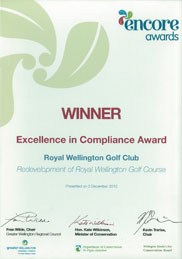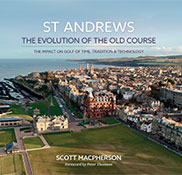GOLF CHAMPIONSHIPS ON SMGD COURSES:
At Close House – Colt Course. Sept 2017. A prestigious European Tour Championship hosted by Lee Westwood.
Broadcast worldwide from Royal Wellington Golf Club, NZ. October 2017. WOW!
The legacy continues.
Co-hosted at the award-winning Millbrook Resort near Queenstown, NZ. 2014 – 2023.
Golf and the Environment
Golf and the Environment share a unique bond. Those who enjoy golf, often enjoy it because it is an opportunity to get outdoors and into a natural environment. Golf course architects are deeply aware of this bond. Designing an experience which enhances this pleasure, often by improving the environmental state of the site, is central to most designs. It is therefore disconcerting when golf courses are accused of damaging the environment.
The use of chemicals and the damage to soils are two of the reasons most often cited by the public as how golf courses damage the environment. But these are, in all but the rarest of circumstances, misconceived perceptions. Golf courses almost always improve the wildlife and habitat of a site. Here are some facts about golf and the environment.
- Research has shown that Golf Courses do not contribute significantly to ground water contamination. When properly applied, pesticides and fertilizers used today on golf courses do not leach into groundwater in any significant amounts.
- Modern turfgrass management practices (such as the use of slow-release nitrogen granulations) can greatly reduce the potential for nitrogen leaching or runoff into water supplies. The organic (thatch) layer in healthy turfgrass also significantly reduces the potential for nutrient “movement”.
- An 18 hole golf course may average 160 acres. Pesticides and fertilizers are only used on certain portions of the golf course. The majority of the property often consists of natural areas that are not maintained with chemicals. These low-maintenance areas usually provide a home for wildlife, and include a diverse variety of native plants and large stands of trees.
- Golf course superintendents are among the best educated and most judicious users of chemical management tools. Today, most superintendents have university degrees in agronomy, horticulture or a related field.
- Because turf chemicals are often expensive, golf course superintendents have an economic incentive not to apply them. What’s more, many superintendents entered the profession because of a love of nature and the outdoors and are strongly committed to conservation.
- Golf courses typically compost grass clippings. This is usually done in low- maintenance areas of the course. In some cases, the compost is recycled as a soil amendment.
- The water used on golf courses can be an excellent investment in both economic and environmental terms. Irrigated golf courses generate billions of tourist and property tax dollars for economies.
When effectively irrigated, healthy turf provides numerous environmental benefits. Properly managed turfgrass:
- Provides oxygen (Carbon dioxide exchange)
- Removes pollutants from the air
- Cools the atmosphere (acts as a heat-sink)
- Absorbs sound and glare
- Prevents erosion
- Filters natural and synthetic contaminants from rainfall and irrigation
- Recharges critical groundwater supplies
- Provides crucial “greenspace” in urban settings
- Computerised irrigation systems and improved turfgrass varieties allow courses to use less water to achieve the same level of conditioning. Continuing research will provide even more “low-water” turfgrass varieties in the future.
- The entire golf community is committed to improving the environment. Significant amounts of money is put into research each year to continue this drive.
10. In addition to turf related benefits, courses provide other important ecological and community assets. Golf courses are…
- Key sanctuaries for birds and other wildlife
- Disposal and treatment sites for wastewater and effluent
- Attractive and environmentally sound “covers” for closed landfills and other ecologically damaged sites
- Places for non- golf recreational activities such as jogging, walking, bird-watching, cross country skiing and fishing.
- Businesses that provide hundreds of thousands of skilled and semi- skilled jobs
- Places for social interaction and community events
- Civic benefactors that give major contributions to charities
- The keystone of a multi-billion-dollar industry worldwide
- Community improvements that add value to land, thus decreasing local tax bases.
* Source; Condensed from The Golf Course Superintendents Association of America.
AWARDS
 Winner
Winner
Excellence in Compliance Award
Royal Wellington Golf Club
 Scott awarded by GEO as a Sustainable Golf Champion
Scott awarded by GEO as a Sustainable Golf Champion
PUBLICATIONS
 St Andrews
St Andrews
The Evolution of the Old Course
by Scott Macpherson
TESTIMONIALS
"RWGC set out to build the best club golf course in New Zealand and to be one that golfers from all around the world will travel to play. We are confident that ambition is being realized."
Peter Cutfield, Chairman, Royal Wellington Golf Club, NZ



